Popular Mechanics (May 1960)
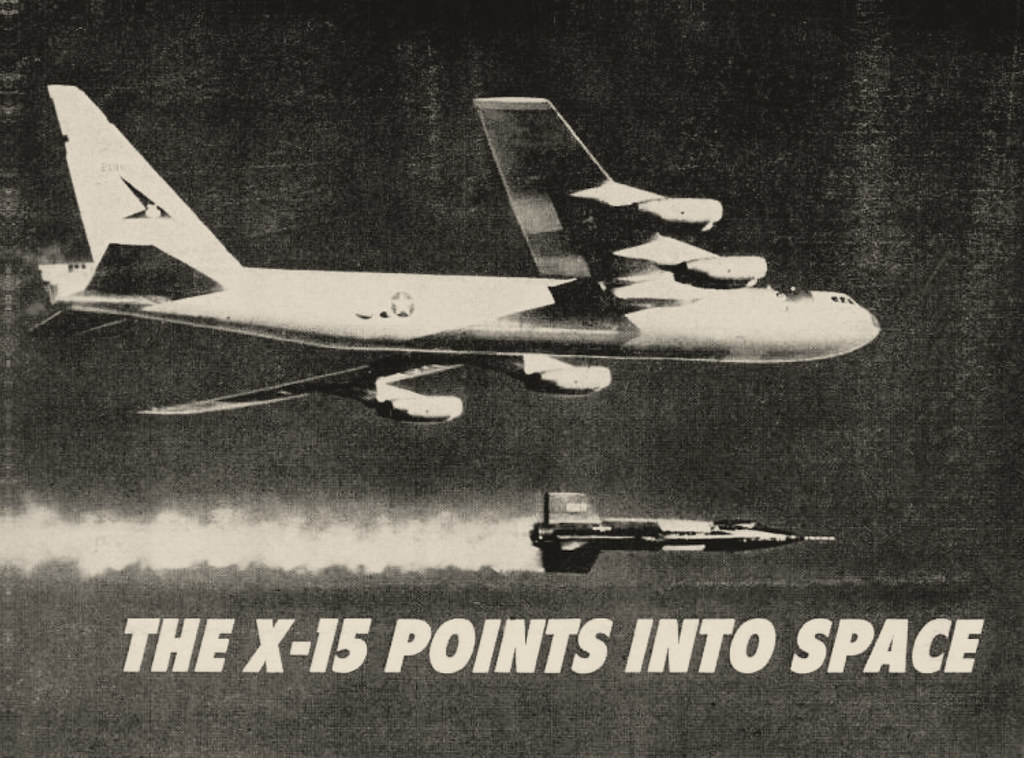
Essentially a manned racket, the X-15 drops from the wings of the B-52 that carried it to 38,000 feet and blasts off. In 88 seconds. its engine can zoom it into a ballistic trajectory at speeds at up to 4000 mph.
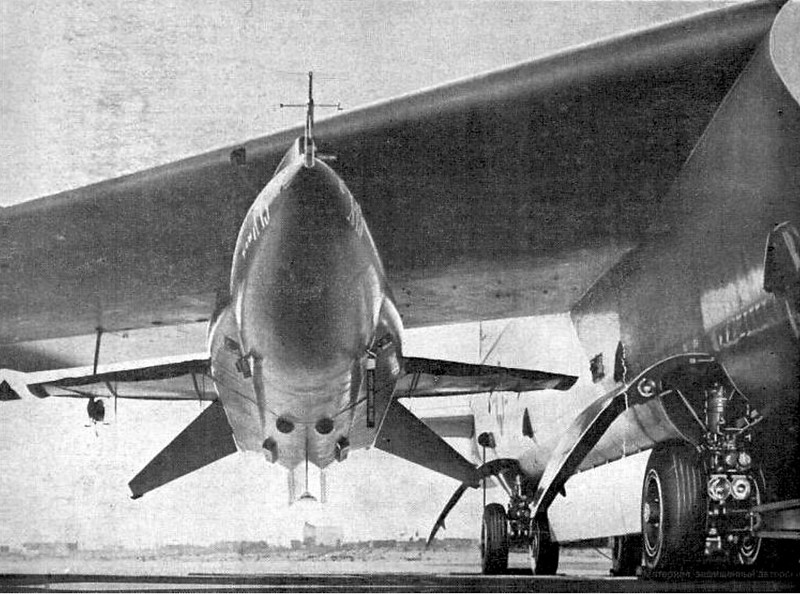
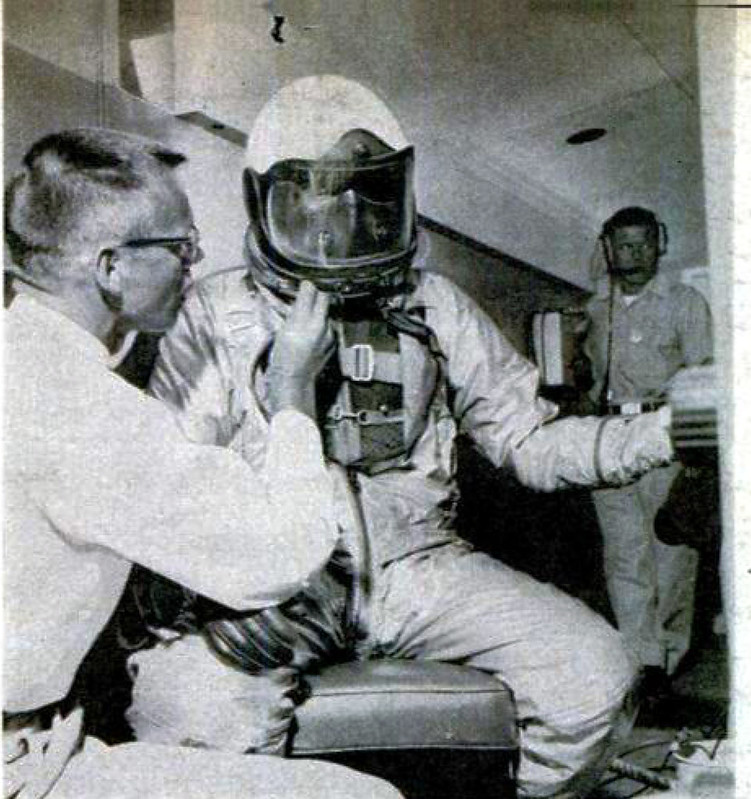
More than an hour before take-off, the X-15 pilot is dressed in an $18,000 space suit made of heat-reflecting aluminum cloth. Taped to his body are sensing devices so that his rate of breathing, temperature and heartbeat can all be monitored.
THE ROCKET with the man in its nose was starting its plunge toward earth and Q. C. Harvey was watching its descent on the radar screen in the high-range control room at Edwards.
Harvey pushed the button on his mike. “X-15 this is Earphone One,” he said. “You look real good. Everything appears normal. Do you read me?”
“Rog, Q.C. Have started re-entry procedure.”
The X-15 rocket was still in space over a neighboring state and yet from the windowless control room at Edwards Air Force Base, Calif. the test conductor was figuratively peering over the pilot’s shoulder.
The radar plotting board showed the geographical location of the X-15 as well as its speed and altitude. Oscillographs duplicated the readings of important cockpit instruments. Technicians were watching scores of meters that told the story of temperatures, pressures and performance.
Even the heartbeat of the pilot was being recorded. All this information was coming by radar and radio telemeter from the X-15.
Q. C. Harvey is responsible for the lengthy, careful countdown that precedes a flight and can cancel it right up to drop time if something goes wrong. During a flight he advises the pilot on procedures and passes on information that may be
radioed from chase planes.
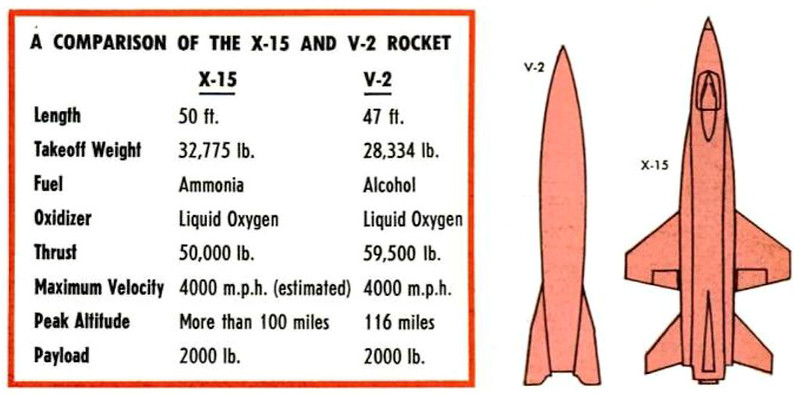
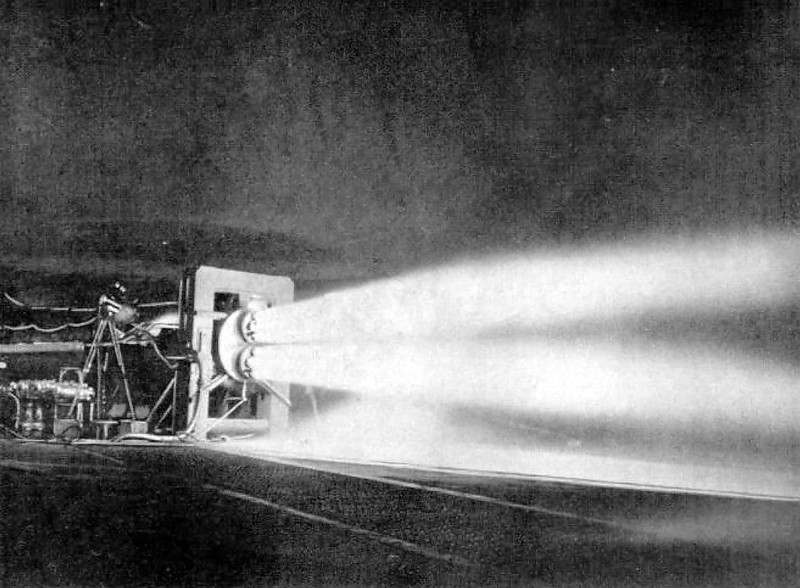
Two-engine power plant of the X-15 is test-fired. A more powerful single-engine plant has been developed.
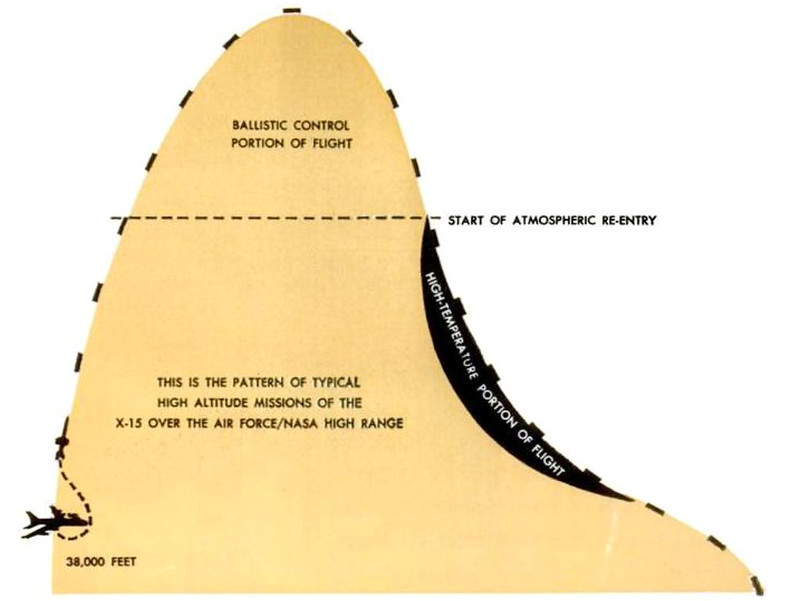
Flights of the X-15 at high altitudes follow the pattern (above), which is a projection for typical flights it is hoped will be made at heights up to 100 miles. Specifications for the research croft call for performance of up to 50 miles. However, it was built to go higher and will, unless heat of re-entry to the earth’s atmosphere proves prohibitive.
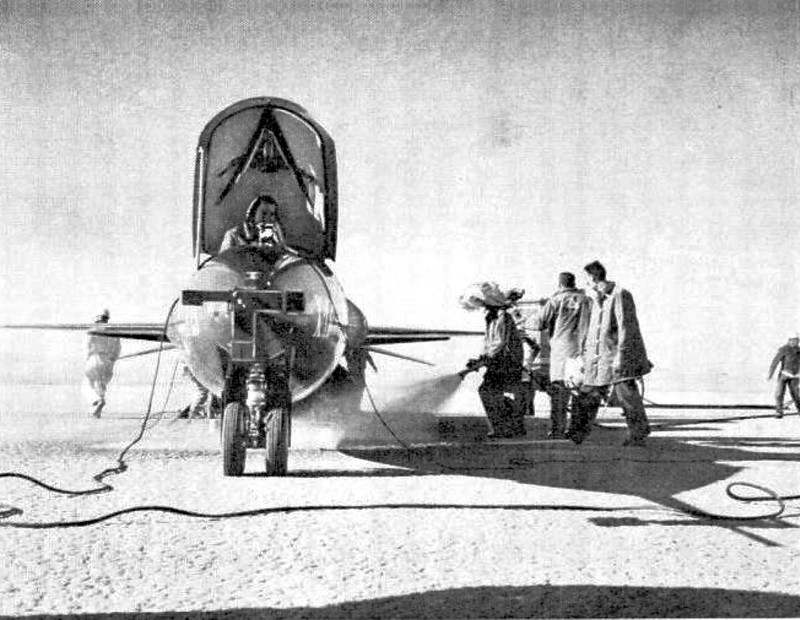
Firemen wash down the landing area in dry lake bed after chemicals were purged from the X-15’s many tanks.
Usually Q.C.’s job looks easy. The pilot flies from memory a flight he had rehearsed on a simulator. He knows when to pull the nose of the X-15 up toward the sky, when to go over the hump in a ballistic trajectory and the angle at which he should re-enter the atmosphere. Harvey can tell at once if the vehicle departs from its program. Usually nothing goes wrong but there are alternate procedures that can be adopted, alternate landing fields that can be used if something does.
The X-15 is called a manned research vehicle rather than an airplane. It has a stubby wing and landing gear so it can land like an airplane. But in most other respects it is a true rocket. In many ways it is like a wartime German V-2. It is three feet longer, weighs a couple of tons more and develops almost as much thrust. Its estimated top speed, in excess of 4000 m.p.h., compares with the 4000 m.p.h. top speed of a V-2. Its peak altitude, in excess of 100 miles, is about the same. It carries 2000 pounds of pilot and instruments instead of 2000 pounds of explosive.
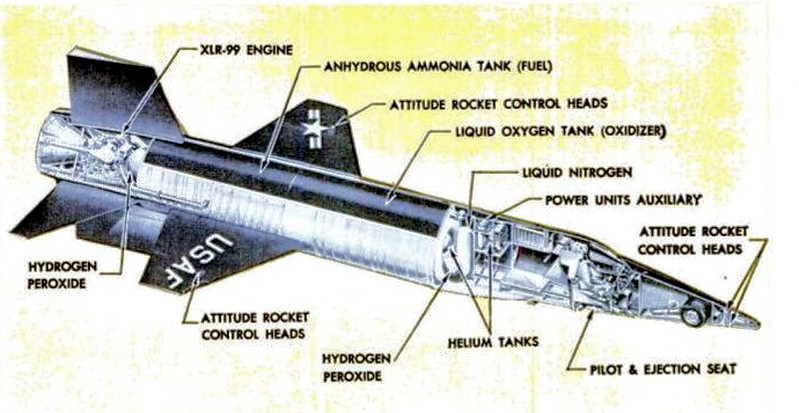
Cutaway drawing of the X-15 shows how the big, 50,000-pound-thrust engine crowds the craft when installed.
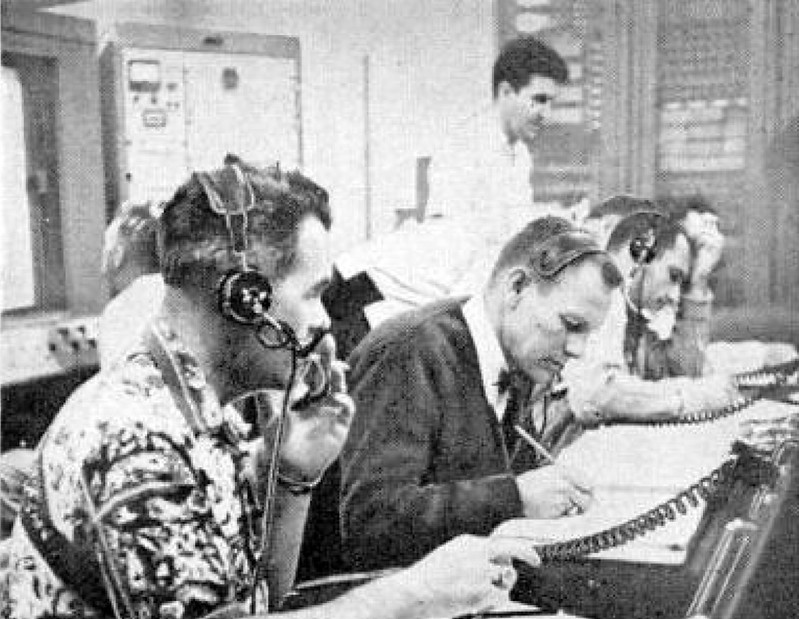
Test conductor Q. C. Harvey, in dark sweater at the high-range control room, talks pilots down should something go wrong.
North American Aviation has built three X-15’s under a contract with the Air Force, Navy, and National Aeronautics and Space Administration. Each craft is 50 feet long with a span of 22 feet. The skin is a heat-treated nickel-steel alloy over a structural frame of titanium and stainless steel. Aluminum is used internally. In addition to its ordinary aerodynamic controls the X-15 has eight tiny jet nozzles in the nose and four in the wings. These reaction controls are used by the pilot at the edge of space.
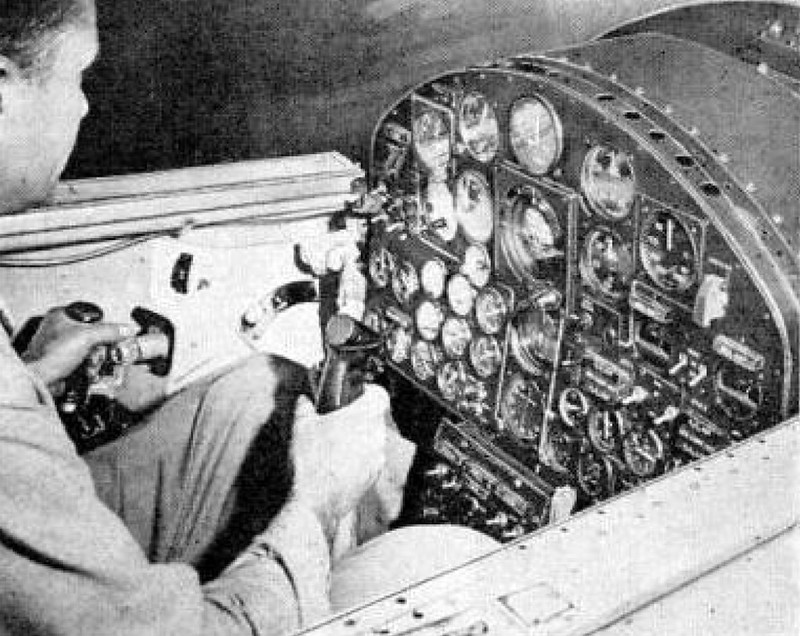
Ground crewman checks out cockpit instruments and controls of X-15 several days before a new flight is scheduled to begin.
The first X-15’s early flights were powered by a pair of rocket motors that developed 16,000 pounds of thrust on water-alcohol and liquid oxygen. Later a single motor that develops 50,000 pounds of thrust on liquid ammonia and liquid oxygen was installed. The motor can be throttled, can be turned on and off in flight. It consumes more than seven tons of fuel and oxidizer in 88 seconds at full throttle. In that short time the craft accelerates from its drop speed of 500 m.p.h. to above 4000 m.p.h.
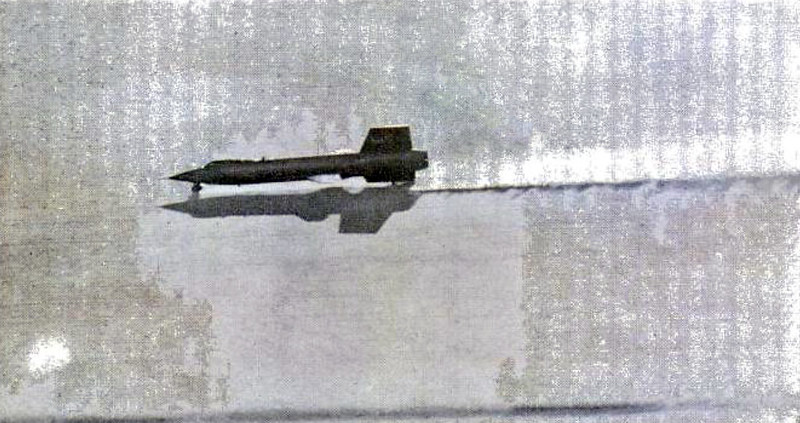
Its research done, an X-15 lands on nose wheel and two rear skids. Some 100 men are involved in each flight.
Research flights began last year and will continue into 1961. It is understood that specs on the X-15 call for a craft capable of sustained flight at Mach 6 at an altitude of 250,000 feet, roughly 50 miles above sea level. But North American designed the plane to fly higher. Eventually, climbs to 100 miles or more may be made unless it is found that the heat of re-entering the atmosphere would be too great. Even in a normal descent from 50 miles the leading edges of the nose and wing will glow bright red with heat. The X-15s are painted black so they can radiate this heat away quickly. The pilot, however, wears a bright silvery suit. Its aluminized cloth is intended to reflect heat that might build up in the cockpit during re-entry or high-speed level flight.
No single pilot has been flying the X-15. Scott Crossfield, backed by Alvin S. White, has been doing the performance flights for North American. The Air Force’s Maj. Robert M. White and NASA’s Joseph A. Walker were assigned as pilots by the purchasers. Each will alternate and each is expected to fly the craft to maximum speed and to maximum altitude.
Never before has such a complex vehicle been built, for never before was it necessary to cram so much energy, in various forms, into such a small space. Seven different gases and liquids are required.
Liquid ammonia is the engine fuel, liquid oxygen is the oxidizer. The LOX tank is something like a spool that is built around a separate, inner tank and separated from it by an air space. Liquid nitrogen at minus 300 degrees is pumped through the air space at the start of servicing and helium gas is pumped into the inner tank. The nitrogen keeps the helium cold until subzero oxygen is loaded and takes over.
The surrounding structure frosts up at the start of this operation and so hot air is circulated through other parts of the craft to prevent freezing of the hydraulic and hydrogen peroxide lines.
The hydrogen peroxide provides a high-temperature gas that drives two auxiliary powerplants, known as APUs. These generate power for the 1300 pounds of instruments and for such odd jobs as defogging the windshield on the way to drop altitude.
The cockpit and the pilot’s suit must be pressurized, and the pilot and instruments must be kept cool during portions of the flight. Liquid nitrogen (pressurized by helium) is used for this. It is converted into gas and is ducted to the instruments, to the cockpit, and to the pilot’s suit. The pilot can’t breath nitrogen, of course, and so oxygen is piped to the mask.
Some of the LOX oxidizer would boil away during the time the X-15 is being carried to its 38,000-foot drop altitude, and the pilot would consume much of his oxygen supply. To avoid this the X-15 feeds off its mother plane during the climb. The LOX tank is topped off from a tank on the B-52, the pilot breathes B-52 oxygen and gets his suit nitrogen from the B-52 until just before the drop. Hot air from the B-52 is circulated through the X-15 until its APUs are started prior to the drop.
Readying such intricate equipment demands a long and exacting countdown. Nearly 100 people are involved. The “servicing pamphlet” is actually a book 11/2 inches thick. There are 79 checkoff steps in preflighting the APUs alone.
Preparations begin five days ahead of time. Systems are inspected and operated. The rocket motor is fired. Movie cameras are installed on the mother plane. The closed-circuit TV by which the launch panel operator on the B-52 checks the X-15 during the climb is tested.
Other groups stand by. The pilots of the two F-104 chase planes, the F-100 photo plane and the photo helicopter are alerted, as are the crews of the back-up chase planes at Edwards and Palmdale.
A two-section convoy proceeds to the landing area on the dry lake bed. Included are fire fighting trucks, ambulance, a mobile crane, crash crew, purging crew, ground photographers and the radio control truck that takes over during landing.
Other crash and fire crews will be spotted at alternate landing areas. Telescopes that make space-positioning photographs of the flight are prepared. Radar and telemetry crews go to their high-range tracking stations at Ely and Beatty, in Nevada. Interested officials from through-out the country converge on Edwards.
The countdown begins 20 hours before the flight is scheduled to start. If takeoff is set for eight in the morning, the task of mounting the X-15 on the B-52 begins at noon the day before. Fueling starts at 3 a.m. and all the other gases and liquids go on board both planes on schedule.
It’s possible to “hold” at any time. Once a countdown was held five days on ac-count of weather. Strong surface winds are a bugaboo. The X-15 can land in a 25 or 30-knot wind but this would be too strong for the pilot in case of a bail-out.
More than an hour before takeoff the pilot starts his personal countdown. He has a dressing room, an air-conditioned trailer, that delivers him to the plane and takes him from it. Two men dress him in the $18,000 space suit and meanwhile the pilot goes on 100-percent oxygen, a pre-requisite for an extremely high altitude flight. Before the dressing starts, however, there are other details. Sensing devices are taped to his body so that his rate of breathing, temperature and heartbeat can be monitored. At the last moment he is driven to the plane.
The chase planes take off, then the B-52 with the black X-15 under one wing. During the half-hour climb to the drop point and altitude, the X-15 pilot has more than 50 jobs to do. He checks his radio equipment, sends preliminary bursts of data by telemeter, operates the controls that start the aircraft’s systems and reports his progress to P. C. Harvey. He finishes pressurizing the X-15 by the time the B-52 pilot gives him the one minute warning, and reports to the mother plane and test conductor that he is ready to be launched. The B-52 pilot starts a short countdown and at “one” presses the button that allows the X-15 to drop away.
Once free of the mother plane, the X-15 pilot fires his rocket motor and begins the flight scheduled for that day.
Each flight is made for different purposes. The idea is to obtain new information on such things as behavior of the vehicle at the speeds and altitudes achieved, the air pressure “Q” factors, the “G” forces, temperatures and the effects on the pilot himself.
Some knowledge from the X-15 program will be used in Project Mercury, the plan for orbiting a man around the earth in the nose cone of a rocket. The X-15 also is a forerunner to Dyna-Soar, the space glider that is intended to circle the earth in 80 minutes after being shot into orbit by a rocket. Like the X-15 pilot, the pilot of Dyna-Soar will control his craft as it re-enters the atmosphere and bring it to a safe landing at a selected spot.
Another vehicle under consideration is the X-15B, a larger version of the X-15. It would be shot into orbit as the third stage of a huge Saturn booster and would travel around the earth at 18,000 m.p.h. at 2000 miles altitude. It would carry two men, a pilot and an observer. It, too, would dive and glide back to a safe landing after using retro-rockets to decelerate. But Mercury, Dyna-Soar and the X-15B are still in the future. Unless the Russians have put a man into orbit since this was written, the X-15 program is man’s closest approach so far to true space flight.
* * *

